Ultimate Guide to Tokyo Public Transportation
The public transportation system of Tokyo consists of 13 subway lines and a large number of railway lines operated by various public and private companies. Railways and subways cover the city and its surroundings so well that bus lines, which do exist, are usually unnecessary for a tourist. Many Tokyo residents have never taken a bus to get around the city in their lives. Tokyo's network of subways and railways is extensive, reliable, punctual, safe, and clean. At the same time, it is one of the aspects that most causes anxiety and doubts in travelers who are about to visit Tokyo for the first time. In this guide, we will discover how public transportation works in Tokyo, what are the most challenging aspects for a foreigner visiting Tokyo for the first time, and how to overcome them to move around the city with ease and safety.
Everything you need to know about Tokyo's public transportation
Why Tokyo's public transportation seems complicated
In this guide, we focus on subways and railways because a tourist in Tokyo will almost never need a bus. Compared to the public transportation networks of many large cities around the world, Tokyo's public transportation has some real complexities that make it initially less intuitive and immediate to understand how to get around the city.
First, let's discover these aspects, and then we will see why they are actually not a problem at all:
- There is not a single company that manages public transportation, but numerous different companies. The subway itself consists of two distinct and separate networks of lines: 9 lines are operated by a company called Tokyo Metro, and 4 lines by a company called Toei Metro. In addition to these 13 underground lines, there are some essential elevated urban railway lines operated by Japan Railways (JR), the national railway company. These lines are comparable to a subway both in capacity and frequency (up to one train per minute during peak hours). These three companies are the main players in Tokyo's public transportation, but it doesn't end there. There are also a series of lines from at least another ten private railway companies, which connect central Tokyo with the city's more peripheral districts and surrounding prefectures. Except for a few exceptions, generally, the lines and stations belonging to different companies are completely separate from each other. This has many implications both in terms of difficulty when changing lines and in terms of cost, as you need to buy two tickets and sum the costs.
- There is no single ticket, you can't "buy a subway ticket" and go wherever you want as you might be used to in many other cities around the world. This applies not only when you need to switch between two different companies, as mentioned above, but also for the lines of the same company. The main reason is that the fares for all public transportation lines in Tokyo (and the rest of Japan) depend on the distance traveled. In many Italian cities, public transportation tickets, at least in central areas, have a single fixed fare. The same applies to some metropolises like Paris or New York. In some very large cities (for example, London), the subway is divided into zones, and you buy a ticket related to the zone within which you intend to travel. In Tokyo, the fare system is more complex than that. The cost of each trip depends on the actual distance in kilometers between the departure station and the arrival station. In fact, each station is equipped with strict turnstiles both at the entrance and exit. If you insert a ticket at the exit that does not correspond to the correct fare to be paid, you will not be able to leave the station.
- These aspects and other reasons make Tokyo's public transportation one of the most expensive in the world.
How to Use Trains and Metro in Tokyo Easily and Without Issues
If you are now confused and worried, keep reading, and you will discover that it is actually very easy to solve all these problems:
- Firstly, nowadays, almost no one buys single paper tickets to use public transport. For many years, Japan has had prepaid cards (called IC Cards) that work not only in Tokyo but throughout the country. Once you get one of these prepaid cards, like the SUICA, you just need to keep your card loaded with enough money, and you can enter any station of any company in any city in Japan and exit at your final destination simply by touching your card on the designated reader. The fare to be paid will be automatically calculated and deducted from your card balance. Prepaid cards for public transport are easy to obtain and can be used to pay for many other things, such as vending machines and many stores inside the stations. Visit this page for more info on SUICA and similar prepaid cards.
- Moreover, most tourists will never need the vast majority of Tokyo's metro and railway lines. Paradoxical as it may seem, you will rarely even need the metro itself. This does not mean that central Tokyo is small. On the contrary, many famous areas of Tokyo are very far from each other and impossible to reach on foot. However, many famous neighborhoods of Tokyo are located a short distance from one of the JR railway stations, particularly along a circular line called the JR Yamanote Line. All private railway lines going towards the suburbs of Tokyo have their terminals at one of the stations on this circular line. Additionally, almost all major shopping districts and the most famous tourist attractions are near a station on this JR Yamanote Line. Among the few exceptions are Asakusa and the Tokyo Sky Tree (served, among others, by the Toei Asakusa Line metro), the area of Roppongi and the Tokyo Tower (served by the Toei Oedo Line metro or Tokyo Metro Hibiya Line) and the artificial island of Odaiba (served by the automatic Yurikamome train and the Rinkai Line).
Language is Not a Problem
One of the most common fears if you have never been to Japan is how to navigate without being able to read the Japanese language, which does not use the Latin alphabet but a completely different writing system. Rest assured, this is not a problem
. In Tokyo, all railway and metro stations provide all kinds of signs in both Japanese and English. This applies to station names on the platforms, signs indicating exits or transfers to other lines, restrooms, and so on. Additionally, on the trains, there are bilingual monitors that show the next station and other useful information, and key information is repeated via loudspeakers in Japanese, English, and often also in Chinese. In the stations, most ticket machines or machines for recharging prepaid cards are also available in English, Chinese, and Korean.
What has just been said is not always true in Japan, as in some smaller cities everything might be only in Japanese. However, throughout Tokyo and other tourist destinations, there is no need to worry about the language for using public transport. In the event of particular unforeseen circumstances where you need to speak with station staff, this could be a problem because English is not widely spoken. To solve this problem, in recent years, station staff are always equipped with a simultaneous English-Japanese translation device (which does not always work perfectly, but better than nothing).
Practical Guide: How to Enter and Exit Tokyo Stations
Both upon entering and exiting, you will find turnstiles similar to the explanatory photo below in almost all railway and subway stations in Tokyo. All turnstiles have a prepaid card reader clearly marked with the "IC" label (
red circles in the photo) where you can tap your prepaid card. Some turnstiles also have a slot for paper tickets (
blue rectangles in the photo). The paper ticket slot is used for both single tickets and passes, including the Japan Rail Pass and other daily passes.
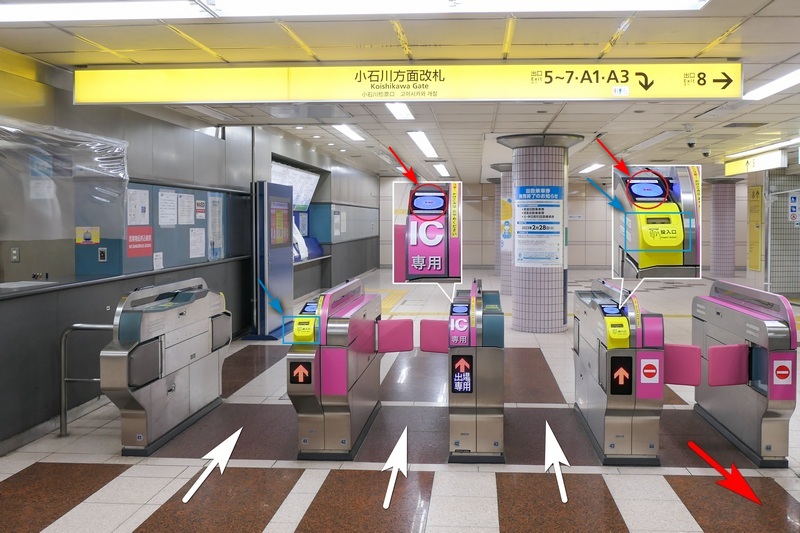
- If you are using an IC Card, when you enter the departure station, tap your IC Card until you hear a beep and proceed. The departure station will be recorded on your card. When you exit at the arrival station, tap your IC Card again until you hear another beep and proceed. The fare for the journey will be automatically deducted from your card balance.
- If you are using a paper ticket, when you enter the departure station, insert the paper ticket into the designated slot, retrieve it from another slot on the other side of the turnstile, and proceed. When you exit at the arrival station, insert the same paper ticket into the designated slot again and proceed. The ticket will not be returned but will remain inside the turnstile.
- If you are using a Japan Rail Pass or another paper pass, when you enter the station, insert the paper pass into the designated slot, retrieve it from another slot further ahead, and proceed. When you exit the metro, insert the paper pass into the designated slot again and retrieve it once more. The passes will always be returned.
What If Something Goes Wrong?
It's very rare for something to go seriously wrong.
The main issue occurs when your IC Card doesn't have enough funds for the journey you've taken. For example, if you only have 200 yen on your card, enough to enter the departure station, but you travel a route costing 300 yen, you won't be able to exit. A similar problem occurs with paper tickets if you purchase a 200-yen ticket and enter, but at the arrival station, that ticket is insufficient for exiting. For such issues, near all exit turnstiles, there are always automatic machines called
fare-adjustment machines, where you can recharge your card or pay the difference between the price of the paper ticket you have and the fare for the route you traveled. Additionally, next to almost all turnstiles, there's always a booth with at least one staff member to assist you with these and other issues.
How to Find Which Line to Take
Figuring out which line to take to travel from point A to point B is very easy nowadays. You can, in order of ease:
- Rely on Google Maps. Tokyo's and the entire country's public transport systems are perfectly integrated with the Google app. It accurately calculates the best route, prices, schedules, and even which car to board on the first train to make transfers quicker if the journey involves a line change. The only problem is that Google directly calculates the fastest route, which might not necessarily be the cheapest or best for you. For example, if you have an active pass and prefer to use lines from a specific company, Google Maps does not allow you to set this option.
- Install and use the Navitime app, available for both iPhone and Android. This app works not only for Tokyo but for public transport across the country, including the high-speed Shinkansen trains. In this app, you can set that you have a certain pass, so you receive the best routes for you. Not all available passes are included, but it does feature both the Japan Rail Pass and the 24/48/72-hour tourist metro pass for Tokyo.
- Like a true old-school explorer, stand in front of one of Tokyo's intriguing public transport maps (we provide a collection at the bottom of the page) and study the route you like best. If you want to study routes in advance to choose which daily pass to buy to save money (professional saver strategies), or to plan your daily itineraries, this is the only choice, possibly aided by some online articles.
Public transportation in Tokyo is very expensive
The only problem that we have not actually solved is the cost. Prepaid cards make it easier to enter and exit stations and save you the hassle of buying tickets, but they do not save you money. Moreover, the presence of all these companies does not make daily passes particularly convenient. There are various subscription options (
visit this page to learn more) but it does not always make sense to purchase them.
Tokyo's public transportation remains among the most expensive in the world, so it is always recommended to plan your itineraries well, dedicating each of your days in Tokyo to visiting areas that are close to each other and choosing accommodation near a convenient and strategic station. If you start moving from one end of the city to the other every day, you will spend a lot of money (and time).
How much does public transportation in Tokyo cost?
Here are the fares for the three main operators, Tokyo Metro, Toei Metro, and JR. The fares depend on the kilometers traveled by train. The kilometers are those actually traveled by the train, not the straight-line distance.
Tokyo Metro fare prices
- 1-6 km: 170¥
- 7-11 km: 200¥
- 12-19 km: 250¥
- 20-27 km: 290¥
- 28-40 km: 320¥
Toei Metro fare prices
- 1-4 km: 180¥
- 5-9 km: 220¥
- 10-15 km: 280¥
- 16-21 km: 330¥
- 22-27 km: 380¥
- 28-46 km: 430¥
Fare prices for JR urban railway lines
For JR, the price depends on numerous factors and cannot be summarized in a short list. JR tends to cost less than the metro for very short routes. For distances over 20 km, the metro becomes more economical. The fares for the JR Yamanote Line range from a minimum of 140¥ to a maximum of 270¥.
Tokyo's public transport operating hours
The operating hours of the metro and other public transport are one of the few drawbacks of this city's fantastic public transportation system. The first trains in the morning, with small differences depending on the lines, run between 5:00 and 5:30, which is fine.
The last trains at night, however, run between midnight and 12:30, with no difference between weekdays and weekends. After this time, the only public transportation available is a taxi. This is a significant handicap for the most populous metropolis in the world, with huge neighborhoods teeming with nightlife. If you want to stay out late in a neighborhood far from your hotel, it is recommended to stay out all night until the first trains in the morning. Alternatively, you can rest for a few hours by finding a
capsule hotel or an
internet cafe in the area.
Rules of conduct on the trains
In many cities around the world, subways are noisy, dirty, and run-down places. This is not the case in
Tokyo, where the local population strictly adheres to a series of behavioral rules that make metro and train cars clean, quiet, and safe places. To avoid standing out and bothering other passengers, it is recommended to:
- Line up to board the train at the designated spots on the platform.
- As soon as the train arrives and the doors open, let the passengers disembark first, and only after everyone has exited, board the train, respecting the line.
- Do not take up too much space, especially during peak hours. If you have a backpack, turn it around and wear it in front of you. In many cities, this is a security precaution to avoid theft. In Tokyo, it is simply a common-sense rule to avoid taking up space for other passengers behind you or accidentally bumping into someone.
- Avoid eating on the train.
- Avoid talking on the phone, listening to music, or watching videos without headphones on the train.
- All trains have some seats reserved for pregnant passengers, the elderly, or those with disabilities. This is the only rule that local people do not always follow. If you want to make a good impression and one of these passengers boards after you, stand up and kindly give them your seat.
- Avoid entering the women-only cars. Many lines offer this type of car, marked in pink and with the "Women Only" sign also in English, during peak hours.
- On escalators, if you do not want to walk, stand strictly on the left side. The right side is left free for those in a hurry. This is the custom in Tokyo. In some other Japanese cities, such as Osaka, it is the opposite.
Public transportation maps in Tokyo
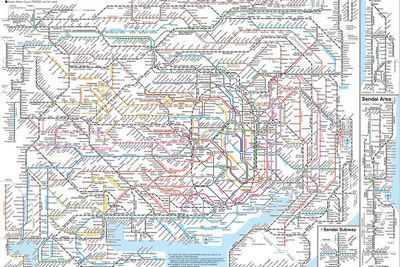
Comprehensive map of Tokyo metro and railways
Updated in 2024
This is the most comprehensive and extensive public transportation map available for Tokyo and its entire metropolitan area, created by JR. It includes all rail lines, including metro, trams, monorails, JR railways, and various private company railways. It covers both the city of Tokyo and the entire surrounding region. On the margins, there are also maps of Niigata and Sendai. The map is very dense with lines and very difficult to read if you do not already have a general knowledge of the various areas and cities.
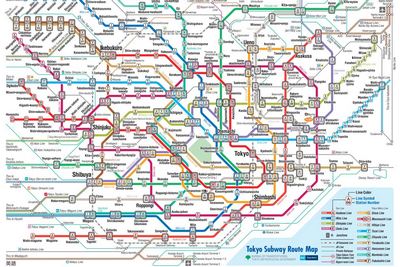
Tokyo Metro map
Updated in 2024
This is the most common map for Tokyo's public transportation and one that you will often find printed in hotels and tourist information centers. It includes all stops on the 13 lines of Tokyo Metro and Toei Metro, and the JR Yamanote Line (the white and gray circular line). It also shows the traces of other JR lines and many private lines, but without providing the details of all stops. It covers the city of Tokyo and its airports.
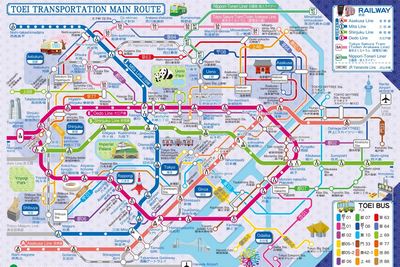
Map of Toei public transportation (metro and bus)
Updated in 2024
This map focuses on the Toei company, which operates four metro lines (Toei Metro) and the city's largest bus network, which, as we have repeatedly said on this page, is never used by tourists. It also includes the JR Yamanote Line. It covers central Tokyo.
For Japan Rail Pass holders
These maps can be useful if you are in Tokyo with an active Japan Rail Pass. On these maps, you can see only those lines that you can ride for free using the Japan Rail Pass.
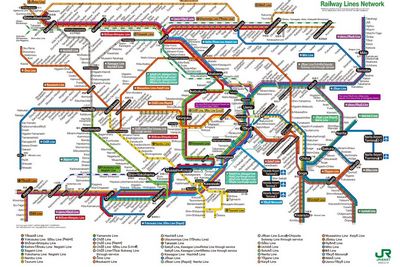
Map of all JR lines in the Tokyo region
Updated in 2024
This map shows all JR lines in the city of Tokyo and the entire surrounding region, including the neighboring prefectures.
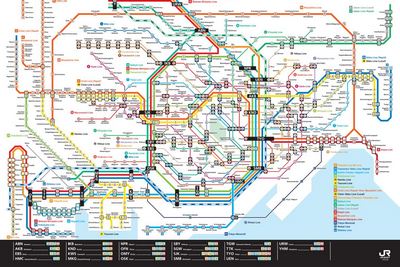
Map of all JR lines in the city of Tokyo
Updated in 2024
This map shows all JR lines focusing on the city of Tokyo and the surrounding areas (Yokohama, Kamakura, Omiya).
Guided tours, activities and other things to do
If you are planning a trip to Japan and you want to do something more than just visiting famous places and monuments, we suggest you to use
Rakuten Travel Experiences.
How to use Rakuten Travel Experiences
Rakuten Travel is a very useful website to
enrich your travel experience, especially if you are going solo or it's your first time in Japan.
Because of the language barrier (and more), in Japan it is very difficult to interact with the locals and to get off the tourist track.
Thanks to Rakuten Travel you can find a lot of interesting and sometimes unique
guided tours and activities all over Japan (and not only in Japan), that you would otherwise never be able to enjoy.
But there's more: on Rakuten Travel you can also
buy tickets for several famous attractions, events, transportation and other useful services for tourists. Last but not least, you can
reserve a table in hundreds of restaurants.
Some examples
Take a look at Rakuten Travel Experiences
You may also be interested in





